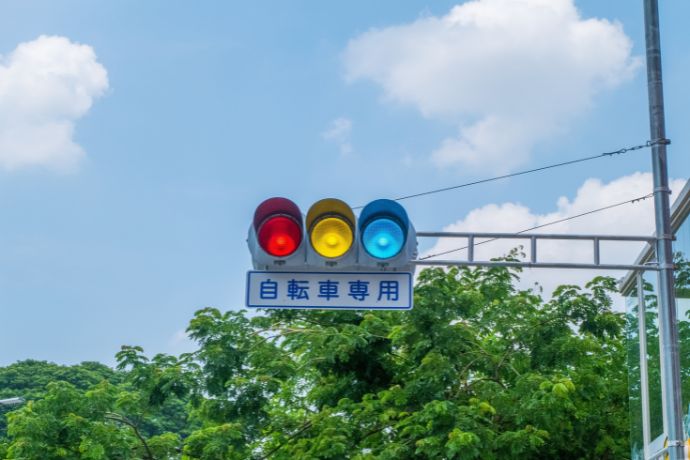Nowadays 青[い] / ao[i] is mostly reserved for blue, except in a few fossilised terms; you’d refer to the greens by 緑 / midori. (“Greens” in both senses - vegs and the colour).
This shift is recent enough to create an issue. International norms require the “go” traffic lights to be green, and when Japan adopted those norms as laws, green was still referred by 青. Nowadays however people understand the word as blue, so…

…you got blue lights. Or rather cyan as a compromise (green enough to fit international norms, blue enough to fit the local law).All new traffic lights in Japan (at least since the switch to LED) are truly green. It is weird to hear some old drivers say “blue” instead of “green” when referring to traffic lights.
I think I have a picture somewhere of a pedestrian crossing light that’s so old it is also more blue than green in color. And it has a frosted glass faceplate instead of plastic.
I’m not surprised that the newer traffic lights are green - blue LEDs are more expensive, specially if you’re trying to reach a specific colour. Perhaps the switch prompted legislative organs to stop trying to interpret the old word through the newer, more restrict, meaning.
This reminds me a similar phenomenon in Portuguese - the so-called terra roxa “purple soil”, actually red:
The case is a bit messier as it likely involves calquing another Romance language that kept Latin rossus as “red”; likely Italian (terra rossa). But under-the-hood, it’s the same phenomenon as those Japanese drivers talking about blue traffic lights - a colour word changing meaning, but the fossilised usage still stuck there.My wife still calls them aoi, but it’s just a normalized thing she grew up with. She uses green now in English.
ok but as a colourblind person those traffic lights are SO much better damn
then again maybe someone who is part blue colourblind might feel differently
I’m only guessing it, but based on this picture I think that cyan instead of green lights should be indifferent for people with tritanopia (no blue channel) or tritanomaly (weak blue channel) - because both should look the same anyway.
staring at this image trying to figure out the difference between deuteranomaly and normal vision before I remembered I’m an idiot
Green is just yellowish blue so.its ok
Colour differentiation in languages is a fascinating topic. Like, some languages have the same word for green and blue, while some, like Ukrainian, have different words for light and dark blue (similarly to pink and red in English). Also, orange as a color is a relatively new word - it was first used only as a fruit name!
Orange is just light brown anyway
It’s interesting, in my language we seldom use it as ‘orange’, most of the time it’s orangeyellow.
Yeah, but not really. They have a word for green, midori, which is much more common. I think the aoi thing is more historical, but since Japan has has Western education for close to a decade (and yes, even before WW2 they sent people to US to copy methods), there’s no generation that grew up without green being green.
Anytime it’s used now it’s just a hold over from those older times, and to be fair English has it’s fair share of antiquated words and phrases.
You see that in English in names of food like red cabbage and red onions.
Indeed, and red cats and red hair are orange.
In Korean “green light” is “파란불” which translates to “blue light / fire” instead of “초록불” this would be "green light / fire. From what I know “초록” the word for green is a relatively new one copied from Chinese, before that it just didn’t exist, instead of that blue and green have been mashed together into one.
We do the same btw, Russian distinguishes between light blue (голубой, goluboy) and blue (синий, siniy), treating them as distinct colors. In English, both are often considered shades of “blue.”
Came to mention the Korean confusion, but ya beat me to it, Lemmy’s other resident 외국인. Hope that aircon is treating ya well. 🥵
Oh man without aircon I think I would be already dead :D
Note that 파란불 isn’t red but is “blue” or sometimes “green” such as for a traffic light. The red light is 빨간불.
Ah damn, I wrote red light instead of green light by mistake, thanks for pointing it out, I’ll fix it!
I really liked how Korean emergency vehicles used to have color-coded lights. Red for fire, blue for police, and green for medical. It was unusual to see, but it made logical sense. Is it now just all standardize on red like Japan?
What most of the resources Im using to learn Japanese have taught me is that it’s a very context sensitive language. The same words can have different meanings or spellings just depending on how they are being used. It can be really confusing at times when learning a “new” word that is the same as a previous word, but now it has a different meaning because it’s using it differently or spelling it differently.
There’s also levels of politeness that change how you might say the same phrase, depending on who you’re saying it to. All I know, so far, is the super professional polite way of saying anything; but nothing I watch to immerse myself in the language uses that form, so even phrases I can understand sound a bit different than how I had learned the phrases.
Portuguese and Hungarian have different words for red.
Well swedish and french too! Röd in Swedish, Rouge in French!
What would be for French? I know Portuguese you have a word for red as blood but a different words for red as in wine
I think they’re just joking that the French word for red differs from the Swedish word for red, therefore stating that Swedish and French have different words for red (because the French red and the Swedish red are not the same).
To be fair, I wanted to make the same stupid joke and I’m relieved that I don’t have to now.
To be fair, most of the time we use the ‘other’ red for stuff that is also expressed by a different word in other languages, such as Spanish: wine (vino
rojotinto /pirosvörös bor), hair (pelorojorubio /pirosvörös haj) and maybe paint/clothes or literature. Other times it’s just the ‘default’ red (piros).
In the novel 1Q84, there’s a character named Aomame, which means “green beans”.







